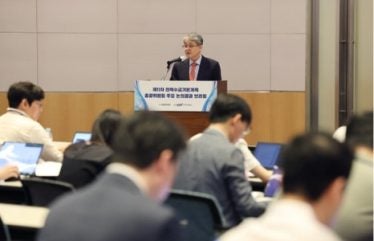
South Korea will build three NPPS and one small modular reactor (SMR) by 2038, accelerating its deployment of nuclear power to meet the increased demand for electricity, according to the first draft of the 11th Basic Plan on Electricity Demand and Supply (BPE). The plan was announced by the advisory committee to the Ministry of Trade, Industry & Energy (MOTIE).
The BPE is a biennial government blueprint that determines the trajectory and components of energy policy. It calculates the amount of electricity Korea is expected to use in the next 15 years and adjusts the type and number of energy sources that are needed. The BPE draft must go through an environmental impact assessment, public hearings and the National Assembly before being formally adopted.
This is the first time since 2015 that MOTIE has produced nuclear newbuild plans. The construction of Shin-Hanul NPP units 3&4, which resumed under the current administration, was approved under the 7th BPE. This is also the first time a BPE has included plan for an SMR. Currently, South Korea operates 26 nuclear reactors, with four under construction.
President Yoon Suk-yeol, who took office in May 2020, has reversed the nuclear phase-out policy of his predecessor, President Moon Jae-who assumed office in 2017 in the wake of the 2011 Fukushima Daiichi accident in Japan.
The advisory committee calculated the expected demand for electricity in 2038 to be 129.3 GWe – an increase of 98.3 GWe (30%) compared with 2023. The increase took into account the demand for data centres and chip production, with a semi-conductor cluster set for construction in Yongin, Gyeonggi.
“It is crucial that the infrastructure for electricity be installed in a timely manner ahead of electrification,” said committee head Jung Dong-wook, a professor at Chung-Ang University and former director of the Korea Nuclear Society.
The committee lowered the targeted portion of electricity that will be generated by nuclear power in 2030 from the 32.4% proposed in the 10th BPE to 31.8% while maintaining the share to be generated by renewable sources at 21.6%. The goal will be for nuclear power to generate 35.6%, and renewable energy to 32.9%, by 2038. The use of hydrogen and ammonia will double over the period, taking up 5.5% of total power generation in 2038.The aim is for more than 70% of energy to be carbon free by 2038. Nuclear accounted for 29.6% of power generation in 2022 and renewables for 8.9%.
“Considering the appropriate reserve ratio (22%), the facilities needed by 2038 are 157.8 GWe, and … confirmed facilities are 147.2 GWe,” MOTIE said. “Therefore, an additional 10.6 GWe of power generation facilities are needed.” This is planned to be covered by large-scale NPPs, SMRs and LNG cogeneration. A construction period of 167 months (13 years and 11 months) is expected to be be required for NPP construction “so the facility plan was prepared based on the assumption that entry will be possible after 2037”.
The ministry said that from 2037-38, 4.4 GWe of new facilities are expected to be needed. If these are APR1400 reactors, up to three units can be built, “but it is recommended that the government consult with the project operator to derive the optimal plan by comprehensively considering the schedule, cost, etc”.
To meet electricity demand from 2035-36, MOTIE says 2.2 GWe of new facilities will be needed. “During this period, 0.7 GWe is allocated for the commercialisation demonstration of small modular reactors currently under development.”
“By building additional nuclear reactors, expanding the use of hydrogen and significantly increasing the use of renewable sources, such as solar and wind power, we can enter the era of carbon-free energy,” a MOTIE official said.


